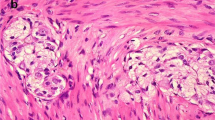Abstract
Objectives
This study was conducted to investigate the pathological changes which occur in interstitial cells of Cajal (ICCs) and ganglion cells found in segments of resected bowel obtained from patients with Hirschsprung’s disease (HD), as well as to explore the benefits of using a contrast enema (CE) with 24-h delayed X-ray films to predict the length of resected bowel.
Methods
We performed a retrospective analysis of 58 children with HD who had undergone the pull-through procedure. After each operation, the ICCs and ganglion cells present in the proximal ends of the barium residue (Level A) and resected proximal bowel segment (Level B) were analyzed using immunohistochemical staining methods. Each patient was followed up for 1 year to record their stool frequency, defecation control ability, and post-surgical complications which may have occurred.
Results
Immunohistochemical staining detected fewer ICCs in Level A than in Level B (p < 0.05). However, the density of ganglion cells in the two levels was not significantly different (p > 0.05). One patient had anastomotic stricture, and five patients suffered from enterocolitis.
Conclusions
The density of ICCs was significantly lower in the bowel segments that displayed barium retention. A CE may be a valuable tool for predicting the length of bowel resection in patients with HD.




Similar content being viewed by others
References
Haricharan RN, Georgeson KE (2008) Hirschsprung disease. Semin Pediatr Surg 17(4):266–275
Langer JC (2013) Hirschsprung disease. Curr Opin Pediatr 25(3):368–374
Coe A, Collins MH, Lawal T et al (2012) Reoperation for Hirschsprung disease: pathology of the resected problematic distal pull-through. Pediatr Dev Pathol 15(1):30–38
Friedmacher F, Puri P (2011) Residual aganglionosis after pull-through operation for Hirschsprung’s disease: a systematic review and meta-analysis. Pediatr Surg Int 27(10):1053–1057
Gfroerer S, Rolle U (2013) Interstitial cells of Cajal in the normal human gut and in Hirschsprung disease. Pediatr Surg Int 29(9):889–897
Wang H, Zhang Y, Liu W et al (2009) Interstitial cells of Cajal reduce in number in recto-sigmoid Hirschsprung’s disease and total colonic aganglionosis. Neurosci Lett 451(3):208–211
Frongia G, Günther P, Schenk JP et al (2016) Contrast Enema for Hirschsprung disease investigation: diagnostic accuracy and validity for subsequent diagnostic and surgical planning. Eur J Pediatr Surg 26(2):207–214
Pratap A, Gupta DK, Tiwari A et al (2007) Application of a plain abdominal radiograph transition zone (PARTZ) in Hirschsprung’s disease. BMC Pediatr 7:5
Wong CW, Lau CT, Chung PH et al (2015) The value of the 24-h delayed abdominal radiograph of barium enema in the diagnosis of Hirschsprung’s disease. Pediatr Surg Int 31(1):11–15
Yang S, Donner LR (2002) Detection of ganglion cells in the colonic plexuses by immunostaining forneuron-specific marker NeuN: an aid for the diagnosis of Hirschsprung disease. Appl Immunohistochem Mol Morphol 10:218–220
de Lorijn F, Kremer LC, Reitsma JB, Benninga MA (2006) Diagnostic tests in Hirschsprung disease: a systematic review. J Pediatr Gastroenterol Nutr 42(5):496–505
Zhang HY, Feng JX, Huang L et al (2008) Diagnosis and surgical treatment of isolated hypoganglionosis. World J Pediatr 4(4):295–300
Yamataka A, Kato Y, Tibboel D et al (1995) A lack of intestinal pacemaker (c-kit) in aganglionic bowel of patients with Hirschsprung’s disease. J Pediatr Surg 30(3):441–444
Rolle U, Piotrowska AP, Nemeth L, Puri P (2002) Altered distribution of interstitial cells of Cajal in Hirschsprung disease. Arch Pathol Lab Med 126(8):928–933
Rolle U, Piaseczna-Piotrowska A, Puri P (2007) Interstitial cells of Cajal in the normal gut and in intestinal motility disorders of childhood. Pediatr Surg Int 23(12):1139–1152
Vanderwinden JM, Rumessen JJ, Liu H et al (1996) Interstitial cells of Cajal in human colon and in Hirschsprung’s disease. Gastroenterology 111(4):901–910
Proctor ML, Traubici J, Langer JC et al (2003) Correlation between radiographic transition zone and level of aganglionosis in Hirschsprung’s disease: implications for surgical approach. J Pediatr Surg 38(5):775–778
Kapur RP, Kennedy AJ (2012) Transitional zone pull through: surgical pathology considerations. Semin Pediatr Surg 21(4):291–301
Langer JC (2012) Laparoscopic and transanal pull-through for Hirschsprung disease. Semin Pediatr Surg 21(4):283–290
Bettolli M, Rubin SZ, Staines W et al (2006) The use of rapid assessment of enteric ICC and neuronal morphology may improve patient management in pediatric surgery: a new clinical pathological protocol. Pediatr Surg Int 22(1):78–83
Langer J, Caty M, de la Torre-Mondragon L et al (2007) IPEG colorectal panel. J Laparoendosc Adv Surg Tech A 17(1):77–100
Acknowledgments
This study was supported by grants from the National Natural Science Foundation of China (No. 81270441).
Author information
Authors and Affiliations
Corresponding author
Ethics declarations
Conflict of interest
The authors report no conflicts of interest.
Rights and permissions
About this article
Cite this article
Chen, X., Zhang, H., Li, N. et al. Pathological changes of interstitial cells of Cajal and ganglion cells in the segment of resected bowel in Hirschsprung’s disease. Pediatr Surg Int 32, 1019–1024 (2016). https://doi.org/10.1007/s00383-016-3961-7
Accepted:
Published:
Issue Date:
DOI: https://doi.org/10.1007/s00383-016-3961-7




